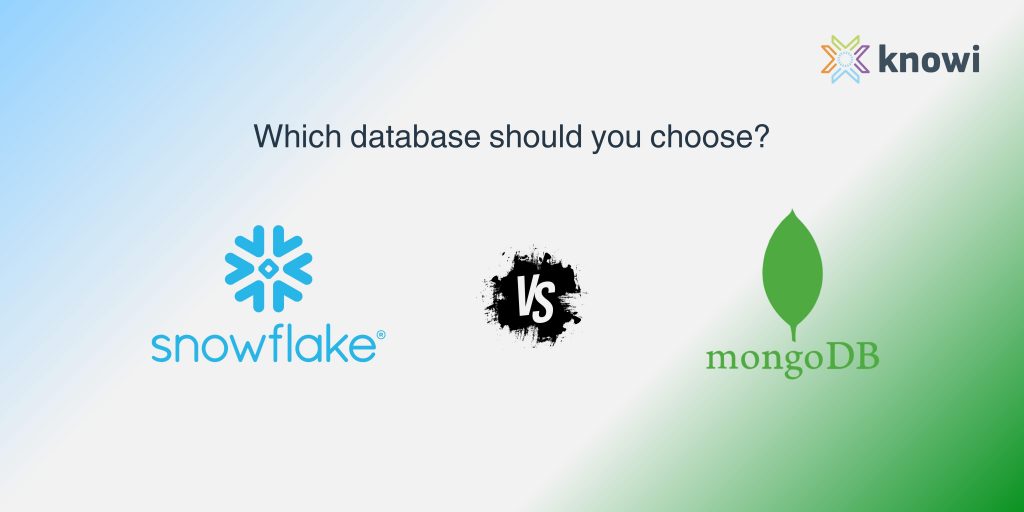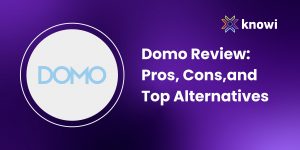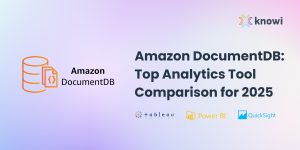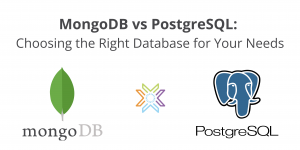Choosing the right database is critical for building your applications. However with so many database choices available today, the decision becomes difficult. All databases have different strengths and weaknesses. This article evaluates two popular databases – Snowflake and MongoDB, diving into what they are, their architecture and a comparison between them.
What is Snowflake?
Snowflake is an analytics database or data warehouse as a service. You can deploy Snowflake on any cloud provider and integrate it with any supported cloud. Essentially, Snowflake is a data warehouse solution hosted on the cloud.
Snowflake is unique because it has a multi-cluster shared architecture. Generally, in database terms, there are two types of architecture: one where multiple nodes talk to a single database instance with multiple compute nodes, and another where nothing is shared—each node has its own replica or database instance running within that particular node, and all nodes are connected. Snowflake combines the benefits of both architectures into what we call a multi-cluster shared architecture. It combines the best of both worlds with central storage and different compute resources surrounding it.
Snowflake is user-friendly, fast, flexible, and scalable. Users can simply install any client or UI for Snowflake and connect directly from their client machine.
Snowflake Architecture
Source: https://docs.snowflake.com/en/user-guide/intro-key-concepts
- Data Storage layer: At the heart of Snowflake architecture is the storage, the central area where all tables and views are stored. Data can be both structured and unstructured. This storage database supports all kinds of relational data types as well as unstructured data in formats like Avro, Parquet, and JSON.
- Query processing layer: On top of the storage layer is the compute layer, a unique feature of Snowflake. Here, you create virtual warehouses connected to the platform where Snowflake is deployed, like GCP, AWS, or Azure. These virtual warehouses can scale up or down based on need and are where queries get executed. Data comes from the central storage, and all virtual warehouses run in parallel without deadlock, continuously fetching data and running queries.
- Cloud services layer: Above the compute layer sits the services layer, the point of entry into the architecture. This layer manages various operational aspects like user authentication, session management, managing virtual warehouses, data updates, and access. It also handles communication with cloud resources and ensures horizontal scalability and availability. The services layer includes metadata management, providing advanced features like zero-copy cloning, time travel, and data sharing capabilities.
A simple user workflow in Snowflake involves a user connecting using client drivers like ODBC, JDBC, or GUI, specifying the warehouse to run the query against. The services layer authenticates the user, creates a query execution plan, and sends it to the selected virtual warehouse. The virtual warehouse executes the query against the central storage, and the results are returned to the user.
In summary, Snowflake is an intuitive and user-friendly data warehouse solution with a unique multi-cluster shared architecture, offering flexibility, scalability, and advanced features. Advantages
What is MongDB?
MongoDB is the world’s most advanced and popular document-oriented database. It was created in 2007 after the team at DoubleClick, a company serving 400,000 ads per second, faced issues with scalability and flexibility using existing database systems. This inspired them to design a database where all data is stored in JSON-like documents, which are organized into collections where they can be queried. Unlike a relational table, a predefined schema for a collection is optional, allowing you to evolve your data structures rapidly without running complex database migrations. More importantly, it allows data that’s frequently accessed together by an app to be stored in the same place. This makes read operations extremely fast because no joins are required. It’s like having a fully assembled car ready to go, as opposed to joining together a bunch of separate parts. This also makes the database much easier to scale horizontally via sharding. Unlike relational tables, collections are self-contained, making them much easier to work with in a distributed system. That’s why they call it Mongo—it’s designed for huge workloads.
MongoDB Architecture
The architecture of MongoDB is built around three primary components: databases, collections, and documents.
- Database: A database is a logical grouping of data housed on a MongoDB server. Each server can host multiple databases, with each database having its own set of files on the filesystem. A database can contain one or more collections of documents.
- Collection: Collections are akin to groups of documents, similar to tables in a relational database but without a fixed schema. Collections can contain an unlimited number of documents, and each document within a collection can have different fields and data types.
- Document: Documents are the core units of data in MongoDB, represented as flexible JSON-like objects. Each document consists of key-value pairs and is schema-less, allowing for varied structures and data types within the same collection. This flexibility enables developers to store complex and evolving data without the constraints of a rigid schema.
In addition to these fundamental components, several key features improve MongoDB’s architecture:
- Storage Engines: MongoDB supports various storage engines, such as WiredTiger and the In-Memory Storage Engine, to optimize performance for specific workloads.
- Query Language: MongoDB’s query language (MQL) is powerful and expressive, facilitating complex data retrieval and manipulation.
- Aggregation Framework: The aggregation framework offers tools for advanced data processing and analysis directly within the database.
- Security: MongoDB includes comprehensive security features such as role-based access control (RBAC) and data encryption to ensure data protection.
Comparison: Snowflake vs MongoDB
| Feature | Snowflake | MongoDB |
| Architecture | Unique hybrid architecture combining elements of shared disk AND shared nothing | NoSQL document-oriented DBMS, known for its flexibility, high performance, availability, and multi-storage engines |
| Data Model | Relational | Document-Oriented |
| Query Language | ANSI-SQL | NoSQL |
| Scalability | Independent scaling of Compute and Storage; near-infinite scalability with dedicated resources. Scales better for analytics workloads by separating storage and compute. | Horizontal scaling with sharding and load balancing. Scales well horizontally for transactions. |
| Performance | Fast query performance with features like multi-cluster shared data architecture, virtual warehouses, caching, materialized views, micro-partitioning, concurrency, and time travel | Prioritizes low-latency read/write performance, allows for rapid retrieval of hierarchical data, and supports indexing, which helps quickly discover documents by different keys or fields |
| Security | Utilizes a multi-layered security architecture with network security, access control, AND end-to-end encryption | Offers security features such as SSL/TLS encryption, RBAC to databases and collections, field-level redaction of sensitive data, encryption, auditing, Integration with Active Directory and LDAP |
| Analytics Workloads | Highly optimized for complex SQL queries at massive scale. | Can handle analytics via Atlas Data Lake, aggregations, and integrations but isn’t optimal for complex SQL queries at massive scale. |
| Governance | Offers robust governance capabilities like column-level security, row-level access policies, object tagging, tag-based masking, data classification, object dependencies, and access history | Compliance with major regulations like HIPAA, PCI DSS, hitrust, vpat, Irap and SOC |
| Ecosystem & Integration | Built-in robust ecosystem of technology partnerships and integrations. Offers connectivity to major BI tools and Connectors | Wide range of Partners and integrations with open source ecosystems |
| Use Cases | Big data analytics, Data warehousing, Data engineering, Data sharing, Machine learning | Content management systems, mobile applications, real-time analytics, IoT data management, e-commerce platforms |
Which database is right for you?
The choice of database truly depends on your particular use case. You can opt for Snowflake if you require a highly scalable and elastic data warehouse optimized for complex analytics workloads. Snowflake excels in scenarios where separating storage and compute is crucial, providing high performance through features like columnar storage, parallel query execution, automatic caching, and clustering. It is well-suited for large-scale data analysis, real-time data warehousing, and situations demanding robust security and governance capabilities.
On the other hand, choose MongoDB if you need a flexible, document-oriented operational database. MongoDB is ideal for applications requiring low-latency reads and writes, such as real-time analytics, content management systems, and IoT applications. Its schema-less design allows for complex queries, secondary indexing, geospatial queries, and data aggregation, making it suitable for scenarios with evolving data structures and the need for high performance via extensive indexing capabilities. MongoDB’s horizontal scalability through sharding and its wide range of programming language support provide versatility for various development environments.
Ultimately, Snowflake is perfect for massive data warehouses and complex analytical workloads, while MongoDB is best for real-time applications, agile development environments, and flexible data structures. Evaluate both databases based on your specific requirements to make an informed decision.
However, neither database offers everything that a user desires. That’s where Knowi comes into picture. Knowi is an end-to-end data analytics capabilities, allows you to natively connect into both these data sources while providing a high-level intuitive UI that allows the users to generate queries and analyze the data with a simple drag and drop functionality. Knowi helps ease the process of data management, data integration and data analysis, helping to process and utilize data more efficiently. Check out the article on MongoDB analytics to learn more. Knowi also provides Snowflake analytics. You can learn about Snowflake analytics here.






